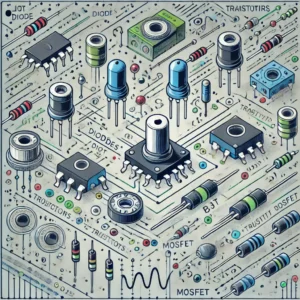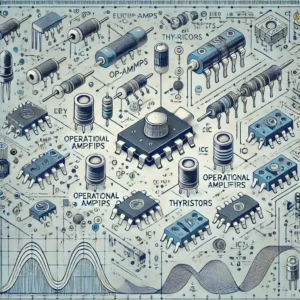EDC Notes Pdf – Electronic Devices and Circuits Pdf Notes Download JNTUH
Here you can download the free lecture Notes of Electronic Devices and Circuits Pdf Notes – EDC Notes Pdf materials with multiple file links to download. The Electronic Devices and Circuits Notes Pdf – EDC Pdf Notes book starts with the topics covering Qualitative Theory of p-n Junction, the p-n junction as a rectifier, the junction transitor, the DC and AC load lines, determination of h-parameters from transistor characteristics, The Junction field effect transistor (construction, principle of operation, symbol) pinch of voltage, FET Common Source Amlifiere, Etc.

Electronic Devices and Circuits Pdf Notes – EDC Notes Pdf
Latest Material Links
Complete Notes
Link – Complete Notes
Unit 1
Link – Unit 1 Notes
Unit 2
Link – Unit 2 Notes
Unit 3
Link – Unit 3 Notes
Unit 4
Link – Unit 4 Notes
Unit 5
Link – Unit 5 Notes
Old Material Links
According to R-13 Notes of Electronic Devices and Circuits Notes Pdf – EDC Pdf Notes
Unit – 1
Download EDC Notes 1 here
Unit – 2
Download EDC Notes 2 here
Unit – 3
Download EDC Notes 3 here
Unit – 4
Download EDC Notes 4 here
UNIT-I
p-n Junction Diode:
Qualitative Theory of p-n Junction. P-n Junction as a Diode, Diode Equation. Volt-Ampere Characteristics, Temperature dependence of V I Characteristics. Ideal versus Practical – Resistance levels ( static and dynamic0 Transition and diffusion capacitances. Diode Equivalent circuits, Load Line Analysis, Breakdown Mechanisms in semi conductor diodes. Zener diode characteristics.
UNIT- II:
Rectifiers and Filters :
the p-n junction as a rectifier, half wave rectifiers, full wave rectifiers, bridge rectifiers harmonic components in a rectifier circuit. Inductor filters, capacitor filtlers, L SECTION filteres, d- section filters. composition of filters, voltage regulation using zener diode.
UNIT- III:
Bipolar Junction Transistor :
the junction transitor, transistor current components. Transistor as an amplifier. Transistor construction. BTJ operation, BJT symbol, common base, common emitter and common collector configuration, limits of operation , BJT specification.
UNIT- IV:
Transistor Biasing and Stabilization :
Operating point, the DC and AC load lines. Need for biasing . fixed bias . collector feedback bias. Emitter feedback bias, collector-emittor feedback bias. Voltage divider bias. Bias stability. Stabilization factors. Stabilization against variations in V BE and beta. Bias compensation using diodes and transistors . thermal runaway, thermal stability.
UNIT-V:
Small Signal Low Frequency BJT Models
BJT hybrid model, determination of h-parameters from transistor characteristics. Analysis of a transistor amplifier circuit using h-parameters. Comparision of CB, CE, and CC amplifiers, configurations.
UNIT- VI:
Field Effect Transistor
The Junction field effect transistor (construction, principle of operation, symbol) pinch of voltage, voltage-ampere characteristics, the JFET small signal model, MOSFET construction, principle of operation, symbol) , MOSFET characteristics in enhancement and depletion modes.
UNIT- VII:
FET AMPLIFIERS :
FET Common Source Amlifiere, Common Drain Amplifier, Generalized FET Amplifier, Biasing FET, FET as Voltage Variable Resistor, Comparision of BJT, and FET., Uni junction Transistor.
UNIT-VIII
Special Purpose Electronic Devices: Priniciple of Operation and Characteristics of Tunnel Diode ( with the help of Energy Band Diagram 0 and Varactor Diode. Principle of Operation of Schottky Barrier Diode, SCR and Semiconductor Photo Diode.
Electronic Devices and Circuits (EDC) Notes Pdf – JNTUH | B.Tech Notes 2025


Looking for comprehensive Electronic Devices and Circuits (EDC) notes for your B.Tech studies? Here, we provide Electronic Devices and Circuits Notes Pdf that cover all essential topics, perfectly aligned with the JNTUH (Jawaharlal Nehru Technological University Hyderabad) syllabus. These notes are ideal for preparing for exams and understanding the fundamental concepts of electronic devices and circuits.
EDC Notes Pdf
The Electronic Devices and Circuits Notes Pdf include topics such as p-n junction diodes, rectifiers, bipolar junction transistors (BJT), field-effect transistors (FET), biasing, amplifiers, and special-purpose electronic devices. These notes will help you gain a strong foundation in electronics.
Electronic Devices and Circuits Pdf Lecture Notes – JNTUH
These EDC Pdf Notes are designed according to the JNTUH syllabus for B.Tech 2025. Whether you’re studying for exams or learning new concepts, these notes provide a clear understanding of electronic devices and circuits.
Electronic Devices and Circuits Notes, PDF | EDC B.Tech (2025)
Here’s your complete guide to Electronic Devices and Circuits Notes with links to download the latest unit-wise materials and complete notes.
Description
The Electronic Devices and Circuits (EDC) course introduces the basic principles of semiconductor devices and their applications in circuits. The course covers the theory and operation of diodes, transistors, FETs, amplifiers, and various special-purpose devices. These topics are crucial for students aiming to understand how electronic circuits work.
Overview of EDC Notes Pdf
These EDC Notes Pdf offer detailed explanations of all key topics in the syllabus. You can download the notes for individual units or the complete set to get a comprehensive understanding of the subject.
The following topics are covered in the Electronic Devices and Circuits handwritten Notes
- p-n Junction Diode
- Rectifiers and Filters
- Bipolar Junction Transistor (BJT)
- Transistor Biasing and Stabilization
- Small Signal Low-Frequency BJT Models
- Field Effect Transistor (FET)
- FET Amplifiers
- Special Purpose Electronic Devices
Links to download EDC Notes Pdf
Download the Electronic Devices and Circuits Notes Pdf from the links provided below for each unit.
- Latest Material Links:
- Unit 1: p-n Junction Diode
Download EDC Unit – 1 Notes - Unit 2: Rectifiers and Filters
Download EDC Unit – 2 Notes - Unit 3: Bipolar Junction Transistor (BJT)
Download EDC Unit – 3 Notes - Unit 4: Transistor Biasing and Stabilization
Download EDC Unit – 4 Notes - Unit 5: Small Signal Low-Frequency BJT Models
Download EDC Unit – 5 Notes
- Unit 1: p-n Junction Diode
- Complete Notes
Download Complete EDC Notes here
EDC Notes and Study Material PDF Free Download
These Electronic Devices and Circuits Notes are available for free download and cover all the key concepts needed to master the subject. Whether you’re preparing for exams or working on projects, these notes will guide you through every step.
Topics Covered in EDC Notes Pdf
Here’s a summary of the major topics covered in the EDC Notes Pdf:
- Unit 1: p-n Junction Diode
- Qualitative theory of p-n junction, diode equation
- Volt-ampere characteristics, temperature dependence, resistance levels
- Transition and diffusion capacitances, breakdown mechanisms, Zener diode
- Unit 2: Rectifiers and Filters
- p-n junction as a rectifier, half-wave and full-wave rectifiers
- Bridge rectifiers, harmonic components, inductor, and capacitor filters
- Voltage regulation using Zener diode
- Unit 3: Bipolar Junction Transistor (BJT)
- Transistor current components, transistor as an amplifier
- BJT construction, operation, and configurations (CE, CB, CC)
- Limits of operation, BJT specifications
- Unit 4: Transistor Biasing and Stabilization
- Operating point, DC and AC load lines, need for biasing
- Various biasing techniques (fixed bias, collector feedback bias, voltage divider bias)
- Bias stability, stabilization factors, bias compensation, thermal stability
- Unit 5: Small Signal Low-Frequency BJT Models
- BJT hybrid model, determination of h-parameters
- Transistor amplifier circuit analysis using h-parameters
- Comparison of CE, CB, and CC amplifier configurations
- Unit 6: Field Effect Transistor (FET)
- JFET construction, operation, pinch-off voltage, V-I characteristics
- JFET small signal model, MOSFET construction, characteristics
- MOSFET operation in enhancement and depletion modes
- Unit 7: FET Amplifiers
- Common source and common drain amplifiers
- Biasing techniques for FET amplifiers, comparison of BJT and FET
- FET as a voltage variable resistor, UJT
- Unit 8: Special Purpose Electronic Devices
- Tunnel diode, Varactor diode, Schottky barrier diode
- Silicon-controlled rectifier (SCR), photodiodes
EDC Notes Pdf from JNTUH
These notes are based on the R09 syllabus for JNTUH. In the R13 syllabus, the 8 units are consolidated into 5 units. Be sure to download the correct set of notes based on your syllabus version.
Always Choose Smartzworld to download EDC Notes PDF
For reliable, high-quality study materials, always choose Smartzworld. We offer a wide range of free, exam-focused resources, including handwritten notes, textbooks, and more.
Benefits of FREE EDC Handwritten Notes PDF
- Easy-to-understand explanations
- Clear, concise, and exam-oriented content
- Free to download and accessible anytime
- Comprehensive coverage of all key topics in Electronic Devices and Circuits
FAQs on Electronic Devices and Circuits Notes
Q1. Where can I download the Electronic Devices and Circuits Notes Pdf?
You can download the notes from the provided links for each unit or the complete set from Smartzworld.
Q2. How to download the EDC Notes Pdf?
Simply click on the download link for each unit or visit Smartzworld to access the full set of notes.
Q3. How many modules are covered in EDC Notes Pdf?
There are 8 modules covering topics such as p-n junction diodes, BJTs, FETs, amplifiers, and special-purpose devices.
Q4. Topics Covered in EDC Notes Pdf?
The topics include diodes, rectifiers, BJTs, transistor biasing, small signal models, FET amplifiers, and special electronic devices.
Q5. Where can I get the complete EDC Handwritten Notes Pdf for FREE?
You can get the complete handwritten notes from Smartzworld for free.
Q6. How to download EDC Handwritten Notes Pdf?
Visit Smartzworld, navigate to the notes section, and download the handwritten notes for free.
Q7. How to Download FREE EDC Notes PDF?
You can download the EDC Notes PDF by following the download links provided above or by visiting Smartzworld.
These Electronic Devices and Circuits Notes Pdf are designed to help you gain a deep understanding of the subject and excel in your exams. Happy studying!
TEXT BOOKS:
- Millman’s Electronic Devices and Circuits – J.Millman, C.C.Halkias, and Satyabratha Jit Tata McGraw Hill, 2nd Ed., 1998 . TMH
- Electronic Devices and Circuits – R.L. Boylestad and Louis Nashelsky, Pearson/Prentice Hall,9th Edition,2006.
- Introduction to electronic devices and circuits-robert t painter PE.
REFERENCES:
- Integrated electronics – J.Millman and Christos c halkias 1991, 2008, TMH.
- Electronic Devices and Circuits – Dr. K. Lal Kishore, B.S. Publications, 2nd Edition, 2005.
- Electronic Devices and Circuits – Anil k maini , varsha agarwal , 2009 WIPL
- Electronic Devices and Circuits – s salivahana n suresh kumar, a vallavaraj 2008 TMH.
Note :- These notes are according to the r09 Syllabus book of JNTUH.In R13 ,8-units of R09 syllabus are combined into 5-units in r13 syllabus.Click here to check all the JNTU Syllabus books
